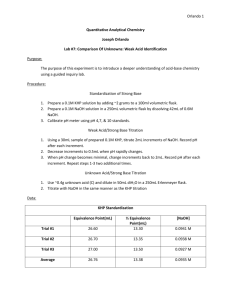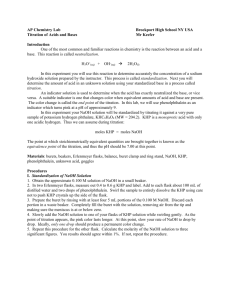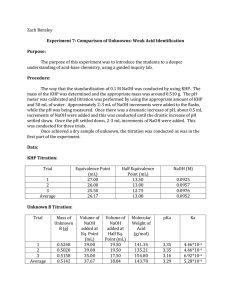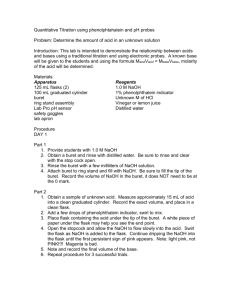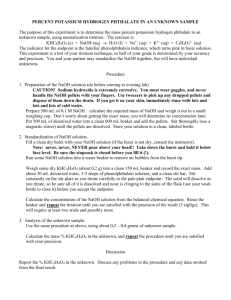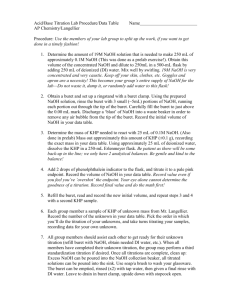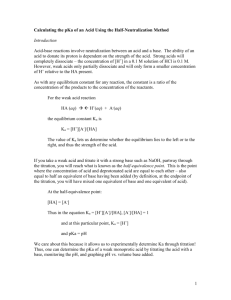Lab #6 Acid-Base Titration
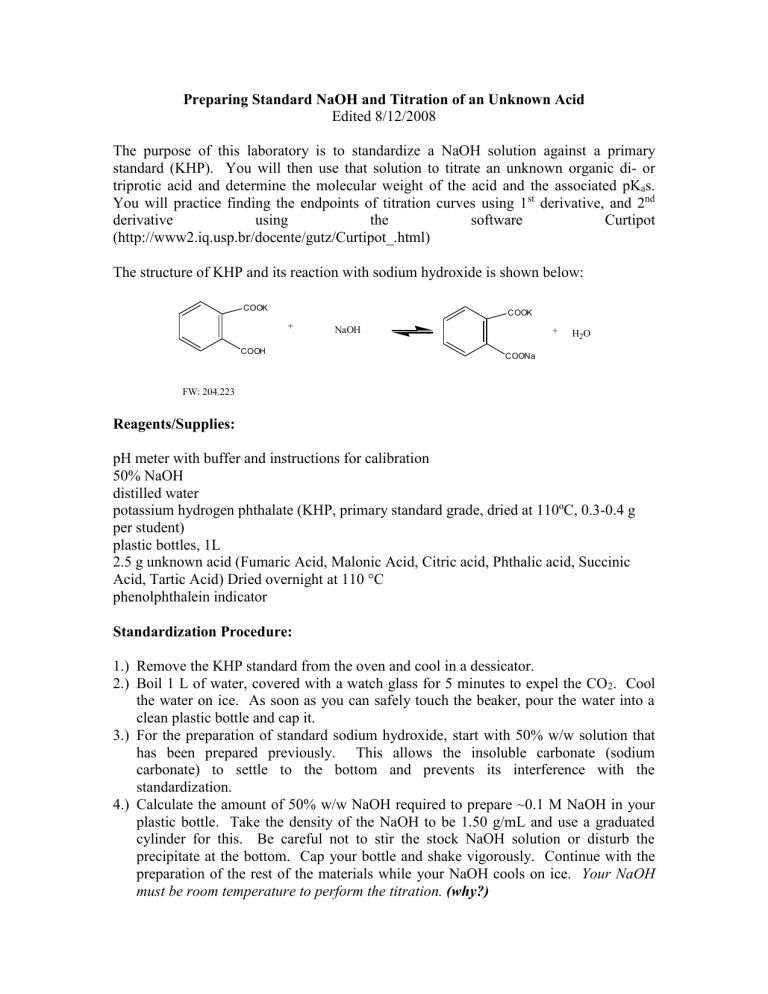
Preparing Standard NaOH and Titration of an Unknown Acid
Edited 8/12/2008
The purpose of this laboratory is to standardize a NaOH solution against a primary standard (KHP). You will then use that solution to titrate an unknown organic di- or triprotic acid and determine the molecular weight of the acid and the associated pK a s.
You will practice finding the endpoints of titration curves using 1 st
derivative, and 2 nd software Curtipot derivative using the
(http://www2.iq.usp.br/docente/gutz/Curtipot_.html)
The structure of KHP and its reaction with sodium hydroxide is shown below:
COOK
COOK
+
NaOH +
H
2
O
COOH
COONa
FW: 204.223
Reagents/Supplies: pH meter with buffer and instructions for calibration
50% NaOH distilled water potassium hydrogen phthalate (KHP, primary standard grade, dried at 110ºC, 0.3-0.4 g per student) plastic bottles, 1L
2.5 g unknown acid (Fumaric Acid, Malonic Acid, Citric acid, Phthalic acid, Succinic
Acid, Tartic Acid) Dried overnight at 110 °C phenolphthalein indicator
Standardization Procedure:
1.) Remove the KHP standard from the oven and cool in a dessicator.
2.) Boil 1 L of water, covered with a watch glass for 5 minutes to expel the CO
2
. Cool the water on ice. As soon as you can safely touch the beaker, pour the water into a clean plastic bottle and cap it.
3.) For the preparation of standard sodium hydroxide, start with 50% w/w solution that has been prepared previously. This allows the insoluble carbonate (sodium carbonate) to settle to the bottom and prevents its interference with the standardization.
4.) Calculate the amount of 50% w/w NaOH required to prepare ~0.1 M NaOH in your plastic bottle. Take the density of the NaOH to be 1.50 g/mL and use a graduated cylinder for this. Be careful not to stir the stock NaOH solution or disturb the precipitate at the bottom. Cap your bottle and shake vigorously. Continue with the preparation of the rest of the materials while your NaOH cools on ice. Your NaOH must be room temperature to perform the titration. (why?)
5.) Weigh four ~0.5 g samples of solid, cooled, KHP (remember to record weights to nearest 0.1 mg) into 125 mL Erlenmeyer flasks.
6.) Add approximately 25 mL of water to each flask. Why does the amount of water not matter?
7.) Add approximately 3-4 drops of phenolphthalein indicator to the flask and swirl.
Pay particular attention to the Table in the book for usable pH range of phenolphthalein indicator and its pK a
.
8.) Wash your buret and rinse the buret with some of your NaOH solution. Fill the buret.
9.) Titrate the 4 samples to a FAINT PINK COLOR. Magenta or dark pink colored samples are NOT ACCEPTABLE and will have to be repeated!!!! During the titration you must swirl the flask. As you begin to see the pink color persist slightly before swirling, you should decrease the flow rate of the buret. Drop wise addition
ALWAYS gives the best results. Remember--YOU ARE GRADED ON YOUR
ACCURACY AND PRECISION!!!
10.) Calculate the average molarity, standard deviation, relative standard deviation and
95% confidence level. Since you have 4 samples, it may be possible to Q-test an outlier. However, if you do this, you must show all calculations to prove that this is appropriate.
Unknown Acid Titration Procedure :
1.) Weigh 0.5 g of your unknown to the nearest 0.1 mg. Quantitatively transfer this unknown to a small beaker. Add 20-30 mL of water. If your sample does not dissolve, you may heat it slightly, but be careful not to overheat the solution as it may decompose.
2.) Quantitatively transfer this solution to a 250 mL volumetric flask and dilute to the mark.
3.) Calibrate your pH meter using buffer solution. Always rinse the electrodes well with distilled water and blot dry with Kimwipes. The glass electrode is very fragile so be careful.
4.) You must perform at least 2 titrations of the unknown.
5.) Pipet 50 mL of unknown into a 125 mL Erlenmeyer flask. Place the flask on a stir plate and add a stir bar. Stir the sample slowly.
6.) Insert the pH meter and position the electrode so that the stir bar does not hit it.
Allow the sample to equilibrate with stirring for 1 minute. Record the pH.
7.) Begin adding your standard 0.1 M NaOH, 0.1 mL at a time and record the pH.
You should follow the titration to at least a pH of 12.
8.) Look at your data and determine where you believe that there are significant jumps in pH for the given volume added. Remember the equivalence point has the most rapid change in pH. These regions are your initial estimations of the equivalence points (your will have 2, possibly 3)
9.) Repeat the procedure.
Unknown Acid Data Analysis :
1.) Type all of your data (Volume added, pH) into an Excel Sheet.
2.) For each titration you must prepare the following graphs in a spreadsheet program. Use CurTiPot to do this by copying your Volume, pH data into the volume and pH column in the Evaluation worksheet. Note you may have to expand or reduce the number of rows used by the software make sure Column C –
F stop where your data stops) Click the “interpolate and smooth button”
CurTiPot will then generate your graphs. a.
pH vs. volume of NaOH (mL) b.
1 st
derivative c.
2 nd derivative
3.) On each graph, you must label the equivalence point(s) and the pK a
(s).
4.) From the equivalence volume and the mass (corrected for buoyancy) of the unknown, calculate the molecular weight of the unknown from each graph. From your plots, report the average, standard deviation, and 95% CL for this molecular weight.
5.) From the molecular weight and the pK a s, determine the identity of your unknown.
Calculate % error for the molecular weight and the pKa(s).
6.) CurTiPot can do much more than this, it can plot any acid. If you know the pKa’s and concentrations, you can use this to check your results. (Try plotting some of the acids using the simulation worksheet (Cell G1 has some general instructions)
7.) CurTiPot can also determine the pKa of your unknown acid (Use the Regression worksheet and read cell M17 for instructions) Regress your best data and record the pKa values, turn in the plot of your data and the regressed data.


